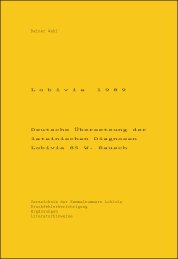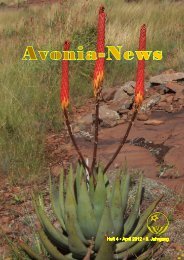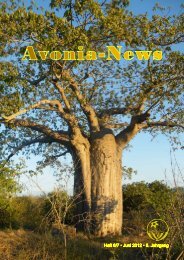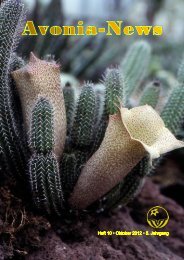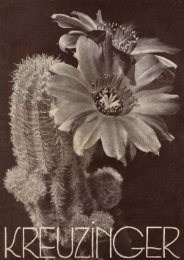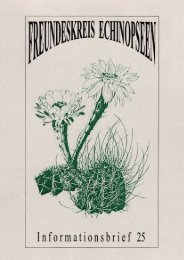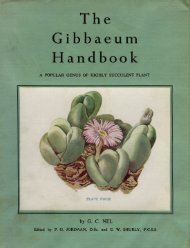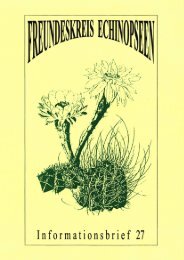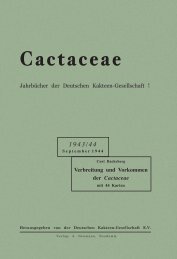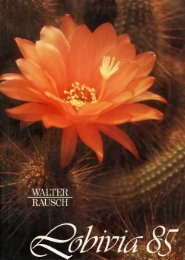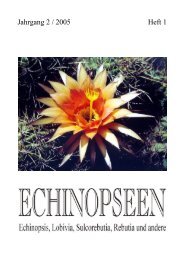journal
journal
journal
You also want an ePaper? Increase the reach of your titles
YUMPU automatically turns print PDFs into web optimized ePapers that Google loves.
THE CACTUS AND SUCCULENT January, 1951<br />
NOTES ON EUPHORBIAS (III)<br />
By J. A. JANSE, F.R.H.S.<br />
(Section Diacanthium)<br />
Euphorbia Royleana Boiss., in D.C., XV, 2, 83 (1862) ; id. in Brandis, Forest Flora of N.W. & C. India, 438 (1874) ;<br />
id. in Hooker, Flora Br. India, V, 255 (1890) ; id. in Berger, Sukk. Euph., 65 (1907) ; E. pentagona Royle, lllustr.<br />
Bot. Himal. Mnt., t 82, fig I, not of Haw (1839).<br />
Original description (translated from the Latin original) ; a shrub, branched ; branches 5-angled, ascending ;<br />
angles acutely prominent, margins undulate with paired spines, more or less subulate, flowers sessile aggregate<br />
or solitary.<br />
This Indian species was first described and illustrated by Royle in his beautiful work on Himalayan plants,<br />
however, the author chose a name already used by Haworth for a South African species, twelve years previously.<br />
Boissier, in his revision of the genus, in De Candolle's Prodromus, therefore, re-named it after Royle. This botanist,<br />
a medical officer in the Indian Army, later Director of the Botanical Garden at Saharanpur, ended his life as Professor<br />
of Botany at Queen's College, London.<br />
Royle's illustration gives a short part of a stem, without leaves and, therefore, apparently made from a specimen<br />
in its resting period. Hooker writes, " leaves not described," and this might have misled Berger to place it in<br />
his sub-section Polygonae between E. canariensis and £. Reinhardtii, two species with which it is only remotely allied.<br />
Its general habit shows much more resemblance with the other Indian species, E. neriifolia L., and E. nivulia Ham.<br />
E. Royleana may be recognised by the 5 to 7-angled, thick stem with the wings sharply prominent. Between them<br />
the sides are rather flat, especially in the older parts of the stem. The large leaves, developed at the tip of the<br />
stem, and soon deciduous, are oblanceolate, at the broadest part 2-| cm. by about 12 cm. in length. In its native<br />
country, the hills of the Suevalak district, it attains a height of 15-16 feet, its circumference being about six feet.<br />
It is difficult to say when E. Royleana has been introduced in our collections ; Berger did not see it in a living<br />
state when compiling his little booklet on Succulent Euphorbias in 1907. I have seen rather large specimens in<br />
the Palmengarten of Frankfurt (Main, Germany), of which one is illustrated in one of the accompanying figures.<br />
Fig. I. E. Royleana Boiss, a young specimen imported from France.<br />
Fig. 2. E. Royleana Boiss, an older specimen in the collection of the Palmengarten, Frankfurt, Germany.<br />
We must apologize to Miss M. Maytham Kidd and to the Botanical Society of South Africa for the wrong<br />
impression and confusion caused by our notice, on page 93, October, 1950. We believed there was only one book<br />
being published, but we now learn there are two. " Wild Flowers of the Cape Peninsula," by Miss M. Maytham<br />
Kidd, by post £3 4s. 2d. and " Wild Flowers of the Cape of Good Hope," issued by the Botanical Society of South<br />
Africa, by post 52/6. These books deal with general flora of South Africa, but contain some succulent material.<br />
Once more we apologize for mentioning the product of one of our advertisers because we feel it is of special<br />
value to the members. We refer to Neale's Photographic Plates. Approximately one hundred plates have already<br />
been issued and their quality and distinctness is extremely good. We need such clear, distinct photographs.<br />
It is not known to many that Curtis' Botanical Magazine commenced, in 1786, as a publication by Curtis and Salisbury,<br />
Seedsmen, of Botanic Nursery, Queen's Elm Turnpike, Brompton, and continues to the present day by the Royal<br />
Horticultural Society and runs into thousands of plates. Neale's Photographic Plates are well on the way to<br />
becoming the Curtis of the cactus and succulent world.<br />
Professor Buxbaum wishes us to draw attention to an unfortunate mistake occurring in the " Euechinocactanae<br />
development " illustration on page 83 of the October, 1950, Journal. In Ramis III Choryphanthanae should, of<br />
course, be Coryphanthanae.



